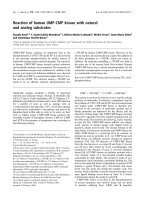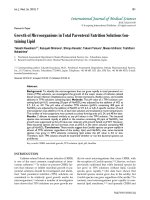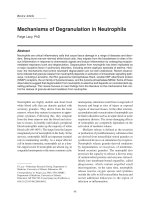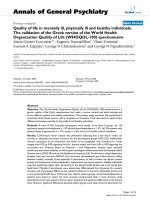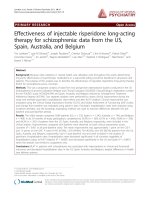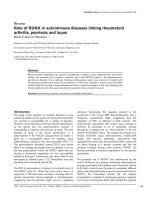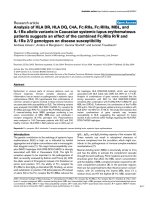Báo cáo y học: "Effectiveness of adalimumab in treating patients with ankylosing spondylitis associated with enthesitis and peripheral arthriti" doc
Bạn đang xem bản rút gọn của tài liệu. Xem và tải ngay bản đầy đủ của tài liệu tại đây (313.54 KB, 10 trang )
RESEARC H ARTIC LE Open Access
Effectiveness of adalimumab in treating patients
with ankylosing spondylitis associated with
enthesitis and peripheral arthritis
Martin Rudwaleit
1*
, Pascal Claudepierre
2
, Martina Kron
3
, Sonja Kary
3
, Robert Wong
4,5
, Hartmut Kupper
3
Abstract
Introduction: The purpose of this study was to investigate the effectiveness of adalimumab in enthesitis and
peripheral arthritis in patients with ankylosing spondylitis (AS).
Methods: Adults with active AS (Bath ankylosing spondylitis disease activity index [BASDAI] ≥ 4) received
adalimumab 40 mg every other week with standard antirheumatic therapies in a 12-week, open-label study.
Effectiveness in enthesitis was assessed using the Maastricht ankylosing spondylitis enthesitis score (MASES, 0-13)
and by examining the plantar fascia in patients with enthesitis (≥ 1 inflamed enthesis) at baseline; effectiveness in
peripheral arthritis was evaluated using tender and swollen joint counts (TJC, 0-46; SJC, 0-44) in patients with
peripheral arthritis (≥ 1 swollen joint) at baseline. Overall effectiveness me asures included Assessment of
SpondyloArthritis International Society 20% response (ASAS20).
Results: Of 1,25 0 patients enrolled, 686 had enthesitis and 281 had peripheral arthritis. In 667 patients with MASES
≥ 1 at baseline, the median MASES was reduced from 5 at baseline to 1 at week 12. At week 12, inflammation of
the plantar fascia ceased in 122 of 173 patients with inflammation at baseline. The median TJC in 281 patients with
SJC ≥ 1 at baseline was reduced from 5 at baseline to 1 at week 12; the median SJC improved from 2 to 0.
ASAS20 responses were achieved by 70.5% of 457 patients with no enthesitis and no arthritis; 71.0% of 512
patients with only enthesitis; 68.0% of 107 patients with only arthritis; and 66.7% of 174 patients with both.
Conclusions: Treatment with adalimumab improved enthesitis and peripheral arthritis in pa tients with active AS.
Trial registration: ClinicalTrials.gov NCT00478660.
Introduction
In additi on to chroni c inflammation of the spine, extra-
axial manifestations are common features in patients
with ankylosing spondylitis (AS). Enthesitis and periph-
eral arthritis, predominantly of the lower limbs, occur in
up to 50% of patients with AS during the course of the
disease [1-5]. These extra-axial manifestations of AS
contribute to the burden of the disease [6,7].
Nonsteroidal anti-inflammatory drugs (NSAIDs)
remain first-line agents for the treatment of AS and can
be used for the treatment of enthesitis [8]. Disease-mod-
ifying antirheumatic drugs (DMARDs) do not have a
satisfactory effect on axial disease. Sulfasalazine ha s
some effect on extra-ax ial arthritis [9] but its benefit for
treating enthesitis does not outweigh its risks [8].
Tumor necrosis factor (TNF) antagonists, including the
monoclonal antibodies adalimumab and infliximab and
the TNF-receptor construct etanercept, are highly effec-
tive agents for the treatment of patients who have active
AS despite NSAID treatment [9-18].
In a 24-week, randomized, double-blind, placebo-con-
trolled study of patients with active AS, 152 adalimu-
mab-treated patients experienced a significant reduction
in enthesitis compared with 81 p lacebo-treated patients
but no significant improvement in pe ripheral arthritis
[15]. Similarly, other randomized controlled trials
(RCTs) of TNF antagonists have not consistently
demon strated significant improvement s in both enthesi-
tis and peripheral arthritis for TNF-antagonist-treated
* Correspondence:
1
Charité-University Medicine Berlin, Benjamin Franklin Campus, Medical
Department I, Rheumatology, Hindenburgdamm 30, 12203 Berlin, Germany
Rudwaleit et al. Arthritis Research & Therapy 2010, 12:R43
/>© 2 010 Rudwaleit et al.; licensee BioMed Central Ltd. This is an open access article distributed under the terms of the Cr eative
Commons Attribution License ( , which permits unrestricted use, distribution, and
reproduction in any medium, provided the original work is properly cited.
patients compared with placebo-treated patients
[10,12,14,16,17]. Only in one RCT of infliximab in AS
were significant imp rovements in both tender joint
count(TJC)andswollenjointcount(SJC)observed
[10]. We evaluated the effec ts of adalimumab on enthe-
sitis and peripheral arthritis in a large cohort of 1,250
patients with active AS who were enrolled in the open-
label RHAPSODY (Review of Safety and Effectiveness
with Adalimumab in Patients with Active Ankylosing
Spondylitis) study [1].
Materials and methods
The patient sample and methods of the RHAPSODY
study, an open-label, multicenter study conducted at
211 centers in 15 European countries, were previously
described in detail [1]. Independent ethics committees
at all participating centers approved the study, and all
participating patients gave written informed consent.
Patients
Patients who were at least 18 years old and who had AS
according to the modified 1984 New York Criteria for
AS [19] and active disease defined by a Bath Ankylosing
Spondylitis Disease Activity Index (BASDAI) score of at
least 4 [20] were eligible for this study if at least one
NSAID or (if stipulated by national guidelines) at least
two NSAIDs had failed to control their disease. Patients
were permitted to continue current AS therapy with
NSAIDs, DMARDs, analgesics, an d glucocorticoids (≤
10 mg/d of prednisone equivalent) during the study.
Intra-articular injections or infiltrations of extra-axial
joints and ten dons were not permitted within 28 days
and injections of sacroiliac joints were not permitted
within 14 days before screening or during the study.
Previous anti-TNF therapy was permitted provided that
etanercept had been discontinued at least 3 weeks or
infliximab had been discontinuedatleast2months
before the first adalimumab injection.
Study design
At baseline, clinicians documented the presence or
absence o f enthesitis and peripheral arthritis. Enthesitis
was defined as at least 1 inflamed enthesis in the Maas-
tricht Ankylosing SpondylitisEnthesitisScore(MASES)
(0 to 13) [21] or of the plantar fascia of the foot. Periph-
eral arthritis was defined as an SJC of at least 1 (0 to 44,
excluding hip joints).
Patients self-administered 40 mg of adalimumab
(Abbott Laboratories, Ab bott Park, IL, USA) subcuta-
neously every other week for 12 weeks. The treatment
effect of adalimumab for enthesitis was assessed by mea-
suringthechangefrombaselinetoweek12inthe
MASES (for patients with MASES of at least 1 at
baseline) and the change from baseline to week 12 in
the percentage of patients with enthesitis of the plantar
fascia (for patients with inflamma tion of the plantar fas-
cia at baseline). The treatment effect of adalimumab for
peripheral arthritis was assessed by measuring the
change in TJCs (0 to 46) and SJCs from baseline to
weeks 2, 6, and 12. Overall adalimumab effectiveness
was measured using the Assessment of SpondyloArthri-
tis International Society 20% and 40% responses
(ASAS20 and ASAS40, respectively) [20,22] and using a
50% improvement in the BASDAI (BASDA I 50) [23,24].
In addition, absolute values at each study visit (weeks 2,
6, and 12, as applicable) and changes from baseline were
calculated for BASDAI (0 to 10) [20], Bath Ankylosing
Spondylitis Functional Index (BASFI) (0 to 10) [25], the
Patient’s Global Assessment of disease activity (PaGA)
(based on a visual analog scale of 0 to 100 mm), and
C-reactive protein (CRP) serum concentration.
Statistical analysis
Patients who had received at least one injection of adali-
mumab were included i n the analyses. Observed data
were used for all effectiveness analyses, and week 12
was specified as the endpoint. Patients with MASES of
at least 1 and patients with SJC of at least 1 were strati-
fied b y sex (male or female), HLA-B27 positivity (posi-
tive or negative), and concomitant DMARD therapy (yes
or no) to analyze changes in MASES, TJC, and SJC. The
effects of adalimumab on AS disease activity and func-
tional disability were evaluated in four subgroups: (a)
patients with no enthesitis and no peripheral arthritis,
(b) patients with enthesitis a nd no peripheral arthritis,
(c) patients with peripheral arthritis and no enthesitis,
and (d) patients with both enthesitis and peripheral
arthritis.
Descriptive analyses were performed by calculating
counts and percentages for qualitative data and by cal-
culating medians and first and third quartiles for quan-
titative data. For the three patient groups without
arthritis and enthesitis, with either peripheral arthritis
or enthesitis, and with both, the Jonckheere-Terpstra
test was applied to test for trends in baseline values and
absolute changes from baseline to week 12 in BASDAI,
BASFI, PaGA, and CRP. For the median absolute
change from baseline to week 12 in MASES, TJC, SJC,
BASDAI, BASFI, PaGA, and CRP, nonparametric 95%
confidence intervals (CIs) were calculated. Correlations
between improvements in AS overall (measured by
changes in BASDAI and in BASFI) and improvements
in extra-axial manifestations (measured by changes in
MASES, plantar fascia, TJC, and SJC) at week 12 were
assessed usi ng the Spearman rank order correlation
coefficient.
Rudwaleit et al. Arthritis Research & Therapy 2010, 12:R43
/>Page 2 of 10
Results
Patient disposition
A total of 1,250 patients with AS were enrolled. Through
week 12, 7.3% of the patients d iscontinued adalimumab
therapy [1]. Of enrolled patients, 457 (36.6%) patients
had no enthesitis and no periphe ral arthritis at baseline
(Figure 1). Enthesitis (MASES or plantar fascia or both of
at least 1) was reported in 68 6 (54.9 %) patien ts. At le ast
one inflamed enthesis in MASES was documented for
667 patients, and inflammation of the plantar fascia was
reported for 173 patients, including 19 patients without
enthesitis in MASES. The distribution of enthesitis sites
at baseline is shown in Figure 2. Of the 281 (22.5%)
patients with peripheral arthritis (SJC of at least 1) at
baseline, 96 had tenderness of the hip joint, indicating
possible hip involvement. Enthesitis without peripheral
arthritis was documented in 512 (41.0%) patients; arthri-
tis without enthesitis was reported in 107 (8.6%) patients.
Both enthesitis and peripheral arthritis were present in
174 of 1,250 (13.9%) patients.
Baseline characteristics
Patients with enthesitis or peripheral arthritis or both
The mean age of patients and the mean duration of AS
were similar between patient subgroups, irrespective of
the presence of enthesitis and arthritis (Table 1). The
percentage of men was lower in the patient subgroups
with enthesitis or peripheral arthritis or both (range,
58.0% to 69.2%) than in the subgroup with no enthesitis
and no arthritis (80.7%). The percentage of patients with
HLA-B27 was lower in the subg roup with both enthes i-
tis and peripheral arthritis (76.0%) than in the other
subgroups (range, 82.2% to 84.1%). The patient sub-
group with peripheral arthritis and no enthesitis had the
greatest percentages of patients receiving concomitant
therapy with DMARDs ( 45.8%) or glucocorticoids
(29.9%). Median BASDAI,BASFI,andPaGAscores
were lower in p atients with no enthesitis and no arthri -
tis than in patients with enthesitis or peripheral arthritis
or both (P < 0.005) (Table 2).
Patients with MASES of at least 1 at baseline
The median MASES was 5 for the 667 patients with
MASES of at least 1 at baseline (Table 3). The median
MASESs were 4 for 432 male patients and 7 for 236
female patients, 5 for both 523 HLA-B27-positive
patients and 126 HLA-B27-negative patients, and 5 for
499 patients without concomitant DMARD treatment at
baseline and 4 for 168 patients with concomitant
DMARD therapy at baseline.
Patients with enthesitis of plantar fascia
The percentages of patients with enthesitis of the plan-
tar fascia were 11.8% in men (105 of 891 men) and
18.9% in women (68 of 359 women).
Patients with a swollen joint count of at least 1 at baseline
The median TJCs and SJCs were 5 and 2, respectively,
at baseline for 281 patients with an SJC of at least 1
Patients with AS enrolled in RHAPSODY (N = 1,250)
(211 sites in 15 European countries)
Patients with
no enthesitis
+ no peripheral arthritis
(n = 457)
Patients with
enthesitis
(n = 686)*
Patients with
peripheral arthritis
(n = 281)
Patients with
enthesitis
+ peripheral arthritis
(n = 174)
Patients with
peripheral arthritis
+ no enthesitis
(n = 107)
Patients with
enthesitis
+ no peripheral arthritis
(n = 512)
Figure 1 Distribution of enthesitis or peripheral arthritis or both in patients with ankylosing spondylitis (AS) (n = 1,250). Enthesit is is
defined as at least 1 inflamed enthesis in Maastricht Ankylosing Spondylitis Enthesitis Score (MASES) or plantar fascia, and peripheral arthritis is
defined as at least 1 swollen joint in a 44-joint count. Data are observed values. *Six hundred sixty-seven patients with enthesitis in MASES and
173 patients with enthesitis of fascia plantaris (19 patients had enthesitis of fascia plantaris without enthesitis in MASES). RHAPSODY, Review of
Safety and Effectiveness with Adalimumab in Patients with Active Ankylosing Spondylitis.
Rudwaleit et al. Arthritis Research & Therapy 2010, 12:R43
/>Page 3 of 10
0 102030405060
Fascia plantaris L
Fascia plantaris R
Achilles tendon L
Achille s tendon R
5th lumbar spine
Iliac crest L
Iliac crest R
Anterior supe rior iliac spine L
Anterior superior iliac spine R
Posterior superior iliac spine L
Posterior superior iliac spine R
7th costochondral joint L
7th costochondral joint R
1st costochondral joint L
1st costochondral joint R
% of Patients
Week 12Baseline
Site of Inflamed Entheses
Figure 2 Percentages of patients with inflamed entheses at baseline and week 12 by enthesitis site (n = 686). Enthesitis is defined as at
least 1 inflamed enthesis in Maastricht Ankylosing Spondylitis Enthesitis Score or plantar fascia and includes patients with ankylosing spondylitis
and enthesitis. Data are observed values.
Table 1 Baseline characteristics in patients with ankylosing spondylitis by subgroup of enthesitis or peripheral
arthritis or both
Patient subgroups
Characteristic No enthesitis
+ no arthritis (n = 457)
Enthesitis
+ no arthritis (n = 512)
Arthritis
+ no enthesitis (n = 107)
Enthesitis
+ arthritis
(n = 174)
Age, years 43.1 ± 11.2 42.7 ± 11.1 46.0 ± 11.9 46.1 ± 12.3
Males, percentage 80.7 67.8 69.2 58.0
HLA-B27-positive, percentage 83.7 82.2 84.1 76.0
AS duration, years 10.9 ± 9.4 10.5 ± 9.7 12.3 ± 10.6 11.8 ± 10.5
Advanced AS, percentage 25.2 28.4 27.6 26.5
Concomitant NSAIDs, percentage 74.0 76.8 73.8 68.4
Concomitant DMARDs, percentage 21.7 22.1 45.8 35.6
Concomitant glucocorticoids
a
, percentage 10.1 10.9 29.9 20.1
Prior TNF-antagonist therapy, percentage 25.8 25.0 27.1 29.3
Data are mean ± standard deviation unless otherwise noted.
a
Systemic treatment with not more than 10 mg of prednisone equivalent daily. AS, ankylosing
spondylitis; DMARD, disease-m odifying antirheumatic drug; NSAID, nonsteroidal anti-inflammatory drug; TNF, tumor necrosis factor.
Rudwaleit et al. Arthritis Research & Therapy 2010, 12:R43
/>Page 4 of 10
(Table 3). Knees (35% of joints), ankles (3 5%), and hips
(30%) were most frequently affected by tenderness,
whereas of the joints of the upper limbs, the greatest
percentages of joint tenderness were observed in the
wrists (28%) and shoulders (27%). Similarly, of the joints
of the lower limbs, the greatest perce ntages of joint
swelling were reported for knees (25%) and ankles (22%)
compared with 19% for the wrists. (The hips were not
evaluated for swelling.) For fingers and toes, swelling
was more frequently reported for the metacarpophalan-
geal joints and proximal interphalangeal joints (4% to
17%) than for the metatarsophalangeal (MTP ) joints (1%
to 6%), probably because swelling in the MTP joints is
difficult to evaluate. The median TJCs were 4 for 175
male patients a nd 7 for 106 female patients, 5 for 217
HLA-B27-positive patients and 6 for 57 HLA-B27-nega-
tive patients, and 4 for 170 patients not receiving conco-
mitant DMARD therapy and 6 for 111 receiving
concomitant DMARD therapy. The median SJC was 2,
regardless of sex, HLA-B27, and DMARD treatment.
Adalimumab effectiveness at week 12
Enthesitis
For patients w ith MASES of at least 1 at baseline, the
median MASES decreased from 5 at baseline to 1 at
week 12; the median change in MASES from baseline to
week 12 was -2 (Table 3). The median MASESs at week
12 were 1 for women (median reduction, -3) and 0 for
men ( median reduction, -2). The improvement in
MASES was independent of HLA-B27 pos itivity and
Table 2 Effectiveness of adalimumab at week 12 in patients with ankylosing spondylitis by subgroup of enthesitis or
peripheral arthritis or both
No enthesitis
+ no arthritis
(n = 457)
Enthesitis
+ no arthritis
(n = 512)
Arthritis
+ no enthesitis
(n = 107)
Enthesitis
+ arthritis
(n = 174)
P value
a
Median First quartile, third quartile [95% confidence interval]
BASDAI, 0 to 10
Baseline 5.9
4.9, 6.9
6.4
5.4, 7.5
6.7
5.7, 7.7
6.6
5.7, 7.6
< 0.001
Week 12 2.1
0.8, 4.1
2.6
1.1, 5.1
3.1
1.5, 4.8
2.7
1.2, 5.0
Change from baseline to week12 -3.6
-4.8, -1.7
[-3.8 to -3.3]
-3.4
-4.9, -1.5
[-3.7 to -3.1]
-3.1
-5.0, -1.8
[-4.0 to -2.7]
-3.5
-4.9, -1.7
[-3.7 to -2.9]
0.813
BASFI, 0 to 10
Baseline 4.9
3.4, 6.7
5.7
4.0, 7.3
5.8
3.7, 7.0
6.0
4.3, 7.5
< 0.001
Week 12 2.2
1.0, 4.3
2.7
1.0, 5.1
3.1
1.4, 5.3
2.8
1.3, 5.3
Change from baseline to week12 -1.9
-3.6, -0.7
[-2.1 to -1.7]
-2.1
-3.8, -0.6
[-2.4 to -1.7]
-1.8
-3.2, -0.7
[-2.2 to -1.5]
-1.9
-3.7, -0.5
[-2.2 to -1.5]
0.828
Patient’s Global Assessment of disease activity, 0- to 100-mm visual analog scale
Baseline 67
49, 80
71
53, 83
72
54, 81
72
53, 83
0.004
Week 12 21
8, 46
24
8, 52
25
11, 48
26
10, 52
Change from baseline to week12 -35
-58, -14
[-40 to -32]
-38
-59, -15
[-42 to -34]
-39
-61, -13
[-48 to -26]
-33
-57, -12
[-41 to -24]
0.806
C-reactive protein
b
, mg/dL
Baseline 1.2
0.6, 2.5
1.2
0.5, 2.4
1.5
0.8,3.6
1.3
0.6, 3.4
0.448
Week 12 0.4
0.2, 0.8
0.4
0.2, 0.8
0.6
0.2, 1.5
0.4
0.1, 0.9
Change from baseline to week12 -0.7
-2.1, -0.1
[-0.9 to -0.6]
-0.8
-1.7, -0.2
[-1.0 to -0.7]
-1.4
-1.7, -0.1
[-1.0 to -0.4]
-0.7
-2.6, -0.1
[-1.3 to -0.4]
0.857
a
P values (two-sided) are based on Jonckheere-Terpstra tests for trends between subgroups without enthesitis and peripheral arthritis, with either enthesitis or
peripheral arthritis, and with both.
b
Reference value is 0.4 mg/dL. BASDAI, Bath Ankylosing Spondylitis Disease Activity Index; BASFI, Bath Ankylosing Spondylitis
Functional Index.
Rudwaleit et al. Arthritis Research & Therapy 2010, 12:R43
/>Page 5 of 10
concomitant DMARD therapy. Enthesitis of the plantar
fascia resolved in 122 of 173 (70.5%) patients (77 men
and 45 women) at week 12. Overall, similar improve-
ments in enthesitis were observed across enthesitis sites
(Figure 2).
Peripheral arthritis
After 12 w eeks of treatment with adalimumab, the TJC
for 281 patients with peripheral arthritis (SJC of at least
1) decreased from a median of 5 at baseline to 1, with a
median reduction of -3 (Table 3). The SJC improved
from a median of 2 at baseline to 0 at week 12, with a
median reduction of -1. Rapid improvement in periph-
eral arthritis was observed, w ith reductions in the med-
ian TJC and SJC documented after a single injection o f
adalimumab; at week 2, the median TJC was 2 and the
median SJC was 0.
Overall
As shown in Figure 3, the percentage of patients achiev-
ing ASAS20 response at week 12 was lowest in the
subgroup of patients with both enthesitis and peripheral
arthritis (66.7%) at ba seline compared with the other
patient subgroups (68.0 to 71.0%), whereas the percen-
tage achieving ASAS40 response was lower in the
subgroup with peripheral arthritis and no enthesitis
(46.0%) compared with the others (50.6% to 56%). Simi-
larly, the percentage achieving a BASDAI50
response was lower in patients with peripheral arthritis
and no enthesitis (52.9%) than in other subgroups
(54.9% to 61.5%). Median changes from baseline to
week 12 and 95% CIs in BASDAI, BASFI, PaGA, and
CRP were similar between patient subgroups (P >0.8)
(Table 2).
Table 3 MASES, tender joint count, and swollen joint count by sex, HLA-B27 positivity, and concomitant DMARD use
All Male Female HLA-B27-
negative
HLA-B27-
positive
No concomitant DMARD at
baseline
Concomitant DMARD at
baseline
Median
First quartile, third quartile
[95% confidence interval]
Patients with enthesitis, MASES ≥ 1 at baseline
MASES: 0 to 13, number
(percentage)
667
(100)
431
(64.6)
236
(35.4)
126
(18.9)
a
523
(78.4)
a
499
(74.8)
168
(25.2)
Baseline 5
2, 8
4
2, 7
7
4, 9
5
2, 9
5
2, 8
5
2, 8
4
2, 8
Week 12 1
0, 4
0
0, 2
1
0, 5
1
0, 5
0
0, 3
0
0, 3
1
0, 4
Change from baseline to
week 12
-2
-5,-1
[-3 to
-2]
-2
-5,-1
[-3 to
-2]
-3
-6,-1
[-4 to
-2]
-2
-5,-1
[-3 to -2]
-3
-6,-1
[-3 to -2]
-3
-5,-1
[-3 to -2]
-2
-5,-1
[-5 to -2]
Patients with peripheral arthritis, SJC ≥ 1 at baseline
TJC: 0 to 46, number
(percentage)
281
(100)
175
(62.2)
106
(37.7)
57
(20.3)
a
217
(77.2)
a
170
(60.5)
111
(39.5)
Baseline 5
2, 12
4
2, 10
7
3, 14
6
3, 13
5
2, 12
4
2, 10
6
3, 13
Week 12 1
0, 3
1
0, 3
1
0, 4
1
0, 4
0
0, 3
0
0, 3
1
0, 4
Change from baseline to
week 12
-3
-8,-1
[-4 to
-2]
-2
-6,-1
[-3 to
-2]
-4
-10,-2
[-6 to
-3]
-3
-10,-1
[-6 to -2]
-3
-7,-1
[-4 to -2]
-2
-7,-1
[-3 to -2]
-3
-9,-2
[-4 to -2]
SJC: 0 to 44, number
(percentage)
281
(100)
175
(62.2)
106
(37.7)
57
(20.3)
a
217
(77.2)
a
170
(60.5)
111
(39.5)
Baseline 2
1, 4
2
1, 3
2
1, 6
2
1, 6
2
1, 4
2
1, 3
2
1, 6
Week 12 0
0, 1
0
0, 1
0
0, 1
0
0, 1
0
0, 1
0
0, 1
0
0, 1
Change from baseline to
week 12
-1
-3,-1
[-2 to
-1]
-1
-3,-1
[-2 to
-1]
-2
-4,-1
[-2 to
-1]
-1
-4,-1
[-2 to -1]
-1
-3,-1
[-2 to -1]
-1
-2,-1
[-1 to -1]
-2
-4,-1
[-2 to -2]
a
Because of missing data, the percentages of patients with HLA-B27 status do not sum to 100%. DMARD, disease-modifying antirheumatic drug; MASES,
Maastricht Ankylosing Spondylitis Enthesitis Score; SJC, swollen joint count; TJC, tender joint count.
Rudwaleit et al. Arthritis Research & Therapy 2010, 12:R43
/>Page 6 of 10
Correlation between improvements in axial disease and
improvements in enthesitis or peripheral arthritis or both
Improvement in A S disease activity and functional sta-
tus, measured by BASDAI and BASFI, respectively, did
not c orrelate with improvement in enthesitis, measured
by MASES and inflammation of the plantar fascia, or
improvement in peripheral arthritis, measured by TJC
and by SJC. Spearman rank order correlation coeffi-
cients ranged from 0.03 to 0.24 across evaluations of the
various combinations of measures.
Discussion
Adalimumab effectiveness and safety were investigated
in a large cohort of patients with AS in an open-label,
uncontrolled, multinational study designed to reflect
routinerheumatologypractice[1].Thepatientshad
long-standing, active AS with a broad range of disease
manifestations typically associated with AS and were
considered eligible for TNF-antagonist therapy [9].
Herein, we specifically assessed the effectiveness of ada-
limumab in AS patients with or without enthesitis or
peripheral arthritis. The baseline frequency of current
enthesitis (54.9%) in this population and that reported
in a previous adalimumab RCT (74%) [ 15] are both
markedly greater than the frequency reported in recent
national observational studies (15% to 30%) [1-3],
whereas the rate of current peripheral arthritis found in
this study w as in accordance with rates reported in the
literature [2].
In t his study, adalimumab therapy was associated with
substantial improvement in enthesitis from baseline to
week 12, as indicated by changes in MASES, and in
inflammation across all exa mined entheses, including
the plantar fascia. Our results are consistent with results
of a previous RCT of adalimumab in 315 patients with
AS [15] and with an RCT of infliximab [14], although
comparison with the latter trial is limited by the use of
disparate enthesitis scores.
In the present study, peripheral arthritis in the 281
patients who had at least 1 swollen joint at baseline
improved rapidly and subs tantially during adalimumab
therapy, with half of the patients reporting no swollen
joints at week 12 (week-12 median TJC = 1 and SJC = 0).
Because of the skewed distribution of values, median data
are presented here. In a previous adalimumab RCT in
which mean data were published [15], the mean change
at week 12 in TJC was -0.8 and the mean change in SJC
was -0.4. By comparison, in our study, the mean changes
from baseline to week 12 were -4.9 for TJC and -2.9 for
SJC, a nd the medi an c hanges were lower than these
mean changes (TJC, -3 and SJC, -1). Significant decreases
in TJC and SJC from baseline to week 12 have been
reported for infliximab therapy for AS [10].
Women with AS had a greater number of inflamed
joints and inflamed entheses at baseline than men.
Althoughthepresenceofcoexistingfibromyalgiain
some of the female patients cannot be excluded, the pat-
tern of enthesitis localization as measured by MASES
70.5
56
61.5
71
54.4
54.9
68
46
52.9
66.7
50.6
55.7
0
20
40
60
80
100
ASAS20 ASAS40 BASDAI 50
% of Patients
No enthesitis + no peripheral arthritis (n = 457) Enthesitis + no peripheral arthritis (n = 512)
Periphera l arthr itis + no enthesitis (n = 107) Enthesitis + peripheral arthritis (n = 174)
Figure 3 Percentages of patients with ankylosing spondylitis achieving response at week 12. Enthesitis is defined as at least 1 inflamed
enthesis in Maastricht Ankylosing Spondylitis Enthesitis Score or plantar fascia, and peripheral arthritis is defined as at least 1 swollen joint in a
44-joint count. Data are observed values. ASAS20/40, Assessment of SpondyloArthritis international Society 20%/40% response; BASDAI 50, 50%
improvement in the Bath Ankylosing Spondylitis Disease Activity Index.
Rudwaleit et al. Arthritis Research & Therapy 2010, 12:R43
/>Page 7 of 10
and examination of the plantar fascia is typical for
enthesitis in AS (Figure 2) [21,26]. Moreover, the finding
that female patients improved as much as male patients
after 12 weeks of adalimumab therapy suggests that
coexisting fibromyalgia did not contribute substantially
to the greater enthesitis count at baseline in women.
The frequency of and improvement in enthesitis and
peripheral arthritis appeared to be unaffected by HLA-
B27 status and concomitant DMARD therapy.
The burden of disease at baseline, as measured by
BASDAI, BASFI, and PaGA, was lower for patients with
no enthesitis and no peripheral arthritis than for
patients with either one or both of these manifestations
( P < 0.005). These results are in accordance with pre-
vious literature reports [7,27,28]. Of note, two studies
showed that a greater BASDAI in patients with periph-
eral arthritis was not associated with the joint-specific
BASDAI items [27,29]. Although disease activity and
physical impairment differed notably at baseline, the
magnitude of improvement with adalimumab therapy in
patients with enthesitis or peripheral arthritis or both
was similar to that observed for patients without these
extra-axial manifestations. At week 12, the median
changes in BASDAI, BASFI, PaGA, and CRP were simi-
lar betwee n all of the various subgroups, and no impor-
tant differences in the degree of improvement were
detected. However, slightly greater ASAS40 and BAS-
DAI 50 response rates were observed for patients with
no enthesitis and no arthritis than for those with en the-
sitis or arthritis or both. The results of this study of
patients with AS categorized by enthesitis and arthritis
are consistent with previous predictor analyses, which
found that enthesitis and arthritis did not influence the
effect of TNF-antagonist therapy [1].
We did not detect any correlation between improve-
ment in BASDAI and BASFI with improvement in
enthesitis or peripheral arthritis. In comparison with
joint counts and enthesitis counts, which capture a sin-
gle domain of AS that may entirely re solve, BASDAI
and BASFI capture many disease domains of AS, each
of which may respond differently to therapy.
Conclusions
In this large cohort of patients with active AS, adalimu-
mab treatment effectively reduced enthesitis and periph-
eral arthritis. Although the burden of disease is greater
when AS is associated with enthesitis or peripheral
arthritis or both, patients with these extra-axial manifes-
tations benefited from adalimumab treatment as much
as patients with axial disease only.
Abbreviations
AS: ankylosing spondylitis; ASAS20/40: Assessment of SpondyloArthritis
international Society 20%/40% response; BASDAI: Bath Ankylosing Spondylitis
Disease Activity Index; BASDAI 50: 50% improvement in the Bath Ankylosing
Spondylitis Disease Activity Index; BASFI: Bath Ankylosing Spondylitis
Functional Index; CI: confidence interval; CRP: C-reactive protein; DMARD:
disease-modifying antirheumatic drug; MASES: Maastricht Ankylosing
Spondylitis Enthesitis Score; MTP: metatarsophalangeal; NSAID: nonsteroidal
anti-inflammatory drug; PaGA: Patient’s Global Assessment of disease activity;
RCT: randomized controlled trial; RHAPSODY: Review of Safe ty and
Effectiveness with Adalimumab in Patients with Active Ankylosing
Spondylitis; SJC: swollen joint count; TJC: tender joint count; TNF: tumor
necrosis factor.
Acknowledgements
The authors thank all investigators and research nurses who contributed to
patient recruitment and data collection in the RHAPSODY study. We also
acknowledge the contributions of the staff at the following sites that have
enrolled at least five patients with AS: Austria: Omid Zamani (Wien), Manfred
Herold (Innsbruck); Belgium: Jean-Pol Dufour (Charleroi), Martin Maertens
(Oostende), Filip van den Bosch (Belsele), Paul van Wanghe (Hasselt), Johan
Vanhoof (Genk), Eric Veys (Gent); Denmark: Karin Grau (Kolding), Palle Holck
(Silkeborg); Finland: Pentti Jaervinen (Hyvinkää), Timo Yli-Kerttula (Turku);
France: Claude Benhamou (Orleans), Thierry Billey (Cahors), Maxime Breban
(Boulogne), Pascal Claudepierre (Creteil), Bernard Combe (Montpellier), Xavier
Deprez (Valenciennes), Liana Euller-Ziegler (Nice), Patrice Fardellone (Amiens),
Pierre Fauquert (Berck), René-Marc Flipo (Lille), Jean Godde (Marseille),
Philippe Goupille (Tours), J-Jean-Luc Grauer (Aix-en-Provence), Pascal
Hilliquin (Corbeil Essonnes), Christian Jorgensen (Montpellier), André Kahan
(Paris), Xavier Mariette (Le Kremlin-Bicêtre), Yves Maugars (Nantes), Pierre
Miossec (Lyon), Alain Saraux (Brest), Jean-Louis Siame (Levin), Jean Sibilia
(Strasbourg), Jaques Tebib (Lyon), Charles Zarnitsky (Montvillier); Germany:
Stefan Bornstein (Dresden), Jürgen Braun (Herne), Harald Burkhardt
(Frankfurt), Edmund Edelmann (Bad Aibling), A Engel (Stuttgart), Georg
Gauler (Osnabrück), Gert Hein (Jena), Maria Höhle (Hamburg), Andreas
Kapelle (Hoyerswerda), Herbert Kellner (München), Jörn Kekow (Vogelsang),
Thilo Klopsch (Neubrandenburg), Ina Kötter (Tübingen), Andreas Krause
(Berlin), Klaus Krüger (München), Brigitte Krummel-Lorenz (Frankfurt),
Johannes Lohmann (Bad Bentheim), Lothar Meier (Hofheim), Ulf Müller-
Ladner (Bad Nauheim), Gunther Neeck (Rostock), Hans-Hartmut Peter
(Freiburg), Constanze Richter (Stuttgart), Matthias Richter (Rostock), Karin
Rockwitz (Goslar), Ekkehard Röther (Villingen-Schwenningen), Andrea
Rubbert-Roth (Köln), Martin Rudwaleit (Berlin), A Seifert (Berlin), Wolfgang
Spieler (Zerbst), Rrainer Sprekeler (Zeven), Hans-Peter Tony (Würzburg),
Harald Tremel (Hamburg), Ulrich von Hinüber (Hildesheim), Jürgen
Wollenhaupt (Hamburg), Silke Zinke (Berlin); Greece: Spyros Aslanidis (Patras),
Kyriaki Boki (Athens), Dimitrios Boumpas (Heraklion), Michail Daniilidis
(Thessaloniki), Lazaros Sakkas (Larisa), Petros Sfikakis (Athens); Italy: Fabrizio
Cantini (Prato), Gianfranco Ferraccioli (Roma), Alessandro Mathieu
(Monserrato), Marco Matucci Cerinic (Firenze), Ignazio Olivieri (Potenza), Carlo
Salvarani (Reggio Emilia), Giovanni Triolo (Palermo), Guido Valesini (Roma);
The Netherlands: Eduard Nicolaas Griep (Leeuwarden), Joanna Rosalia Maria
Griep-Wentink (Den Helder), Steffen Zanen (Zwolle); Norway: Erik Rødevand
(Trondheim); Spain: Alberto Alonso (Barakaldo), Melchor Alvarez Vega
(Madrid), Maria Brito (Madrid), L Carreno (Madrid), Maria del Pilar Fernandez
Dapica (Madrid), Jose Luis Fernandez-Sueiro (Elche), Eduardo Loza Cortina
(Pamplona), Carlos Rodriguez Lozano (Las Palmas de Gran Canaria), José A.
Roman Ivorra (Valencia), Agusti Sellas (Barcelona), Juan Carlos Torre (Oviedo),
Juan Tovar Beltran (Elche); Sweden: Awat Jalal (Öerebro), Åke Thörner
(Eskilstuna); Switzerland: Beat Michel (Zürich), R Theiler (Zürich), Peter Villiger
(Bern); UK: Mohammed Akil (Sheffield), Ernest Choy (London), Robert Cooper
(Manchester), Christopher Edwards (Southampton), Paul Emery (Leeds), Karl
Gaffney (Norwich), Emmanuel George (Merseyside), David Grennan (Wigan),
Richard Hull (Portsmouth), Paresh Jobanputra (Birmingham), Lesley Kay
(Newcastle), Andrew Keat (Harrow), Bruce Kirkham (London), Robert Moots
(Liverpool), Andrew Ostor (Cambridge), Millicent Stone (Bath), Paul
Wordsworth (Oxford). We thank Ioanna Mantika for study management
(Abbott Laboratories, UK), Christa Zaiti-Runkel for data management,
Angelika Freitag and Anja Bruhn for statistical programming (Abbott GmbH
& Co. KG), and Dana L Randall (Arbor Communications, Inc., Ann Arbor, MI,
USA) and Michael A Nissen (Abbott Laboratories) for writing and editing
support in the development and revision of this manuscript. This support
was funded by Abbott. Abbott Laboratories funded the researc h reported in
this manuscript and the manuscript’s preparation. The RHAPSODY Study
Rudwaleit et al. Arthritis Research & Therapy 2010, 12:R43
/>Page 8 of 10
Group included experts from academic institutions in Europe and the US
and members of Abbott Laboratories, who were responsible for the design
of the original clinical trial. Collection and analyses of clinical data were
performed by Abbott Laboratories.
Author details
1
Charité-University Medicine Berlin, Benjamin Franklin Campus, Medical
Department I, Rheumatology, Hindenburgdamm 30, 12203 Berlin, Germany.
2
Service de Rhumatologie, Hôpital Henri Mondor-APHP, Université Paris XII,
avenue du Maréchal de Lattre de Tassigny 51, 94010 Créteil, France.
3
Abbott
GmbH & Co KG, Knollstraße 50, 67061 Ludwigshafen, Germany.
4
University of
Medicine and Dentistry of New Jersey, 189 New Street, New Brunswick, NJ
08901-1954, USA.
5
Formerly Abbott Laboratories, Parsippany, NJ, USA.
Authors’ contributions
All authors contributed to manuscript development and reviewed and
approved the content of the submitted manuscript.
Competing interests
MR and PC were RHAPSODY study investigators. MR has received consulting
fees, speaking fees, and honoraria from Abbott, MSD (München, Germany),
Schering-Plough Corporation (Kenilworth, NJ, USA), Pfizer Inc (New York, NY,
USA), and Wyeth (Madison, NJ, USA). MK and HK are employees of Abbott
GmbH & Co KG (Ludwigshafen, Germany), an affiliate of Abbott Laboratories,
and hold shares of Abbott stock. SK is a contractor of Abbott GmbH & Co
KG. RW was an employee of Abbott Laboratories at the time this study and
these analyses were completed and holds shares of Abbott stock.
Received: 4 November 2009 Revised: 8 February 2010
Accepted: 15 March 2010 Published: 15 March 2010
References
1. Rudwaleit M, Claudepierre P, Wordsworth P, Cortina EL, Sieper J, Kron M,
Carcereri-De-Prati R, Kupper H, Kary S: Effectiveness, safety, and predictors
of good clinical response in 1250 patients treated with adalimumab for
active ankylosing spondylitis. J Rheumatol 2009, 36:801-808.
2. Cruyssen Vander B, Ribbens C, Boonen A, Mielants H, de Vlam K, Lenaerts J,
Steinfeld S, Bosch Van den F, Dewulf L, Vastesaeger N: The epidemiology
of ankylosing spondylitis and the commencement of anti-TNF therapy
in daily rheumatology practice. Ann Rheum Dis 2007, 66:1072-1077.
3. Collantes E, Zarco P, Muñoz E, Juanola X, Mulero J, Fernández-Sueiro JL,
Torre-Alonso JC, Gratacós J, González C, Batlle E, Fernández P, Linares LF,
Brito E, Carmona L: Disease pattern of spondyloarthropathies in Spain:
description of the first national registry (REGISPONSER) extended report.
Rheumatology 2007, 46:1309-1315.
4. Rudwaleit M, Haibel H, Baraliakos X, Listing J, Märker-Hermann E, Zeidler H,
Braun J, Sieper J: The early disease stage in axial spondyloarthritis: results
from the German spondyloarthritis inception cohort. Arthritis Rheum
2009, 60:717-727.
5. Brophy S, Calin A: Ankylosing spondylitis: interaction between genes,
joints, age at onset, and disease expression. J Rheumatol 2001,
28:2283-2288.
6. Boonen A, van der Linden SM: The burden of ankylosing spondylitis. J
Rheumatol Suppl 2006, 78:4-11.
7. Braun J, van der Heijde D, Dougados M, Emery P, Khan MA, Sieper J, van
der Kinden S: Staging of patients with ankylosing spondylitis: a
preliminary proposal. Ann Rheum Dis 2002, 61 Suppl 3:iii9-iii23.
8. Sidiropoulos PI, Hatemi G, Song I-H, Avouac J, Collantes E, Hamuryudan V,
Herold M, Kvien TK, Mielants H, Mendoza JM, Olivieri I, Østergaard M,
Schachna L, Sieper J, Boumpas DT, Dougados M: Evidence-based
recommendations for the management of ankylosing spondylitis:
systemic literature search of the 3E Initiative in Rheumatology involving
a broad panel of experts and practising rheumatologists. Rheumatology
2008, 47:355-361.
9. Zochling J, Heijde van der D, Dougados M, Braun J: Current evidence for
the management of ankylosing spondylitis: a systematic literature
review for the ASAS/EULAR management recommendations in
ankylosing spondylitis. Ann Rheum Dis 2006, 65:423-432.
10. Bosch van den F, Kruithof E, Baeten D, Herssens A, de Keyser F, Mielants H,
Veys EM: Randomized double-blind comparison of chimeric monoclonal
antibody to tumor necrosis factor alpha (infliximab) versus placebo in
active spondyloarthropathy. Arthritis Rheum 2002, 46:755-765.
11. Gorman JD, Sack KE, Davis JC Jr: Treatment of ankylosing spondylitis by
inhibition of tumor necrosis factor alpha. N Engl J Med 2002,
346:1349-1356.
12. Braun J, Brandt J, Listing J, Zink A, Alten R, Golder W, Gromnica-Ihle E,
Kellner H, Krause A, Schneider M, Sörensen H, Zeidler H, Thriene W, Sieper J:
Treatment of active ankylosing spondylitis with infliximab: a randomized
controlled multicentre trial. Lancet 2002, 359:1187-1193.
13. Braun J, Baraliakos X, Brandt J, Listing J, Zink A, Alten R, Burmester G,
Gromnica-Ihle E, Kellner H, Schneider M, Sörensen H, Zeidler H, Sieper J:
Persistent clinical response to the anti-TNF-alpha antibody infliximab in
patients w ith ankylosing spondylitis over 3 years. Rheumatology (Oxford)
2005,
44:670-676.
14. Heijde van der D, Dijkmans B, Geusens P, Sieper J, DeWoody K,
Williamson P, Braun J, Ankylosing Spondylitis Study for the Evaluation of
Recombinant Infliximab Therapy Study Group: Efficacy and safety of
infliximab in patients with ankylosing spondylitis: results of a
randomized, placebo-controlled trial (ASSERT). Arthritis Rheum 2005,
52:582-591.
15. Heijde van der D, Kivitz A, Schiff MH, Sieper J, Dijkmans BA, Braun J,
Dougados M, Reveille JD, Wong RL, Kupper H, Davis JC Jr, ATLAS Study
Group: Efficacy and safety of adalimumab in patients with ankylosing
spondylitis. Arthritis Rheum 2006, 54:2136-2146.
16. Calin A, Dijkmans BA, Emery P, Hakala M, Kalden J, Leirisalo-Repo M,
Mola EM, Salvarani C, Sanmartí R, Sany J, Sibilia J, Sieper J, Linden van der S,
Veys E, Appel AM, Fatenejad S: Outcomes of a multicentre randomized
clinical trial of etanercept to treat ankylosing spondylitis. Ann Rheum Dis
2004, 63:1594-1600.
17. Davis JC Jr, Heijde van der D, Braun J, Dougados M, Cush J, Clegg DO,
Kivitz A, Fleischmann R, Inman R, Tsuji W, Enbrel Ankylosing Spondylitis
Study Group: Recombinant human tumor necrosis factor receptor
(etanercept) for treating ankylosing spondylitis: a randomized,
controlled trial. Arthritis Rheum 2003, 48:3230-3236.
18. Furst DE, Keystone EC, Kirkham B, Kavanaugh A, Fleischmann R, Mease P,
Breedveld FC, Smolen JS, Kalden JR, Burmester GR, Braun J, Emery P,
Winthrop K, Bresnihan B, De Benedetti F, Dörner T, Gibofsky A, Schiff MH,
Sieper J, Singer N, Van Riel PL, Weinblatt ME, Weisman MH: Updated
consensus statement on biological agents for the treatment of
rheumatic diseases, 2008. Ann Rheum Dis 2008, 67(Suppl 3):iii2-iii25, A
published correction appears in Ann Rheum Dis 2009, 68:452
19. Linden van der S, Valkenburg HA, Cats A: Evaluation of diagnostic criteria
for ankylosing spondylitis: a proposal for modification of the New York
criteria. Arthritis Rheum 1984, 27:361-368.
20. Garrett S, Jenkinson T, Kennedy LG, Whitelock H, Gaisford P, Calin A: A new
approach to defining disease status in ankylosing spondylitis: the Bath
Ankylosing Spondylitis Disease Activity Index. J Rheumatol 1994,
21:2286-2291.
21. Heuft-Dorenbosch L, Spoorenberg A, van Tubergen A, Landewé R, van ver
Tempel H, Mielants H, Dougados M, Heijde van der D: Assessment of
enthesitis in ankylosing spondylitis. Ann Rheum Dis 2003, 62:127-132.
22. Anderson JJ, Baron G, Heijde van der D, Felson DT, Dougados M:
Ankylosing spondylitis assessment group preliminary definition of short-
term improvement in ankylosing spondylitis. Arthritis Rheum 2001,
44:1876-1886.
23. Braun J, Pham T, Sieper J, Davis J, Linden van der S, Dougados M,
Heijde van der D, ASAS Working Group: International ASAS consensus
statement for the use of anti-tumour necrosis factor agents in patients
with ankylosing spondylitis. Ann Rheum Dis 2003, 62:817-824.
24. Braun J, Davis J, Dougados M, Sieper J, Linden van der S, Heijde van der D,
ASAS Working Group: First update of the international ASAS consensus
statement for the use of anti-TNF agents in patients with ankylosing
spondylitis. Ann Rheum Dis 2006, 65:316-320.
25. Calin A, Garrett S, Whitelock H, Kennedy LG, O’Hea J, Mallorie P,
Jenkinson T: A new approach to defining functional ability in ankylosing
spondylitis: the development of the Bath Ankylosing Spondylitis
Functional Index. J Rheumatol 1994, 21:2281-2285.
26. Aloush V, Ablin JN, Reitblat T, Caspi D, Elkayam O: Fibromyalgia in women
with ankylosing spondylitis. Rheumatol Int 2007, 27:865-868.
27. Heuft-Dorenbosch L, van Tubergen A, Spoorenberg A, Landewé R,
Dougados M, Mielants H, Tempel van der H, Heijde van der D: The
Rudwaleit et al. Arthritis Research & Therapy 2010, 12:R43
/>Page 9 of 10
influence of peripheral arthritis on disease activity in ankylosing
spondylitis patients as measured with the Bath ankylosing spondylitis
disease activity index. Arthritis Rheum 2004, 51:154-159.
28. Sivas F, Mermerci Başkan B, Erkol Inal E, Akbulut Aktekin L, Barça N,
Ozoran K, Bodur H: The relationship between enthesitis indices and
disease activity parameters in patients with ankylosing spondylitis. Clin
Rheumatol 2009, 28:259-264.
29. Song IH, Rudwaleit M, Listing J, Sieper J: Comparison of the Bath
Ankylosing Spondylitis Disease Activity Index and the modified version
of the index in assessing disease activity in patients with ankylosing
spondylitis without peripheral manifestations. Ann Rheum Dis 2009,
68:1701-1707.
doi:10.1186/ar2953
Cite this article as: Rudwaleit et al.: Effectiveness of adalimumab in
treating patients with ankylosing spondylitis associated with enthesitis
and peripheral arthritis. Arthritis Research & Therapy 2010 12:R43.
Submit your next manuscript to BioMed Central
and take full advantage of:
• Convenient online submission
• Thorough peer review
• No space constraints or color figure charges
• Immediate publication on acceptance
• Inclusion in PubMed, CAS, Scopus and Google Scholar
• Research which is freely available for redistribution
Submit your manuscript at
www.biomedcentral.com/submit
Rudwaleit et al. Arthritis Research & Therapy 2010, 12:R43
/>Page 10 of 10

